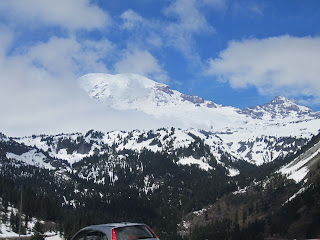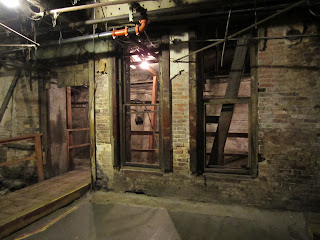 |
| Front Gate |
The Pacific Crest Trail runs from Mexico to Canada through several mountain ranges, and also circles Mount Rainier in the process. The section that runs through the National Park is called the Wonderland Trail and is approximately 90 miles and has elevation changes of about 22,000 feet. This is a foot bridge that is part of the trail, which I followed for a while in the afternoon.
 |
| Don't lose your balance on the footbridge... |
One of the visitor centers was called Paradise, which is about 5,500 foot elevation. As you can see there was a lot of snow left, even in June. This was one of the few times during the day that the clouds broke and the summit was visible. Several people were hiking in the snow, many of which had never seen snow before. It was quite amusing to see all of them who bought full snowsuits, snowshoes, and ski poles for walking on a snow trail. I did get questioned several times for walking in the snow with just my tennis shoes, jeans, and sweatshirt.
Just recently the hotel at Paradise reopened. It looked like a good place to stay during the summer, but there are pictures in the winter of the roof being completely covered with snow.
 |
| One of the few glimpses of wildlife during the day |
The main visitors center is called Longmire for the family that originally settled there in the late 1800s. They made their home near a meadow that they later discovered to be a mineral spring. I believe the orange water here is filled with iron. The family started marketing the mineral springs to have healing power, and built baths for guests to visit.
There were several bridges during the day, and on every one I had a strong desire to bounce a golf ball across.
This deer was not frightened by people at all, and was eating right next to the trail. It is slightly different than the frightened reaction back home.
This cougar was shot near the park entrance in the early 1900s by a ranger, and has been on display in the visitors center ever since.
When I was just about to leave for the day, the clouds decided to break up, and I did get a nice view of the mountain. It was too bad I was not able to stay longer, as the weather became very nice.

























































